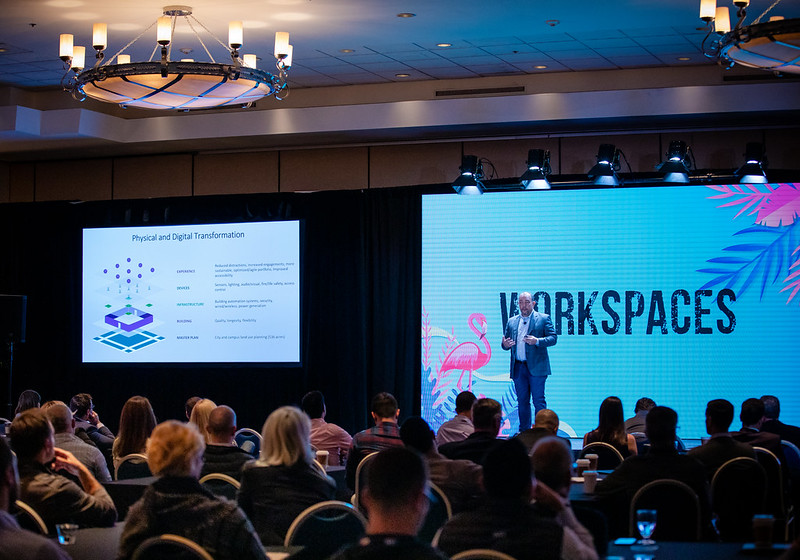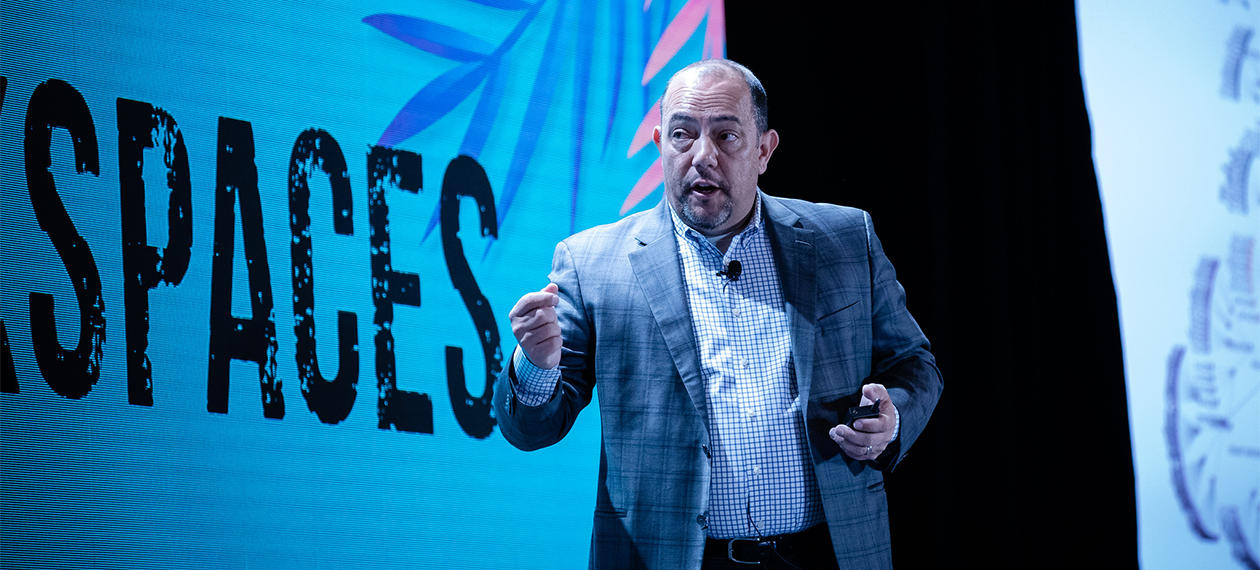When creating the plans for the redevelopment of its iconic Redmond Campus in Puget Sound, Microsoft knew it was undertaking a mammoth project.
How massive? With 72 different firms, five architects, three general contractors, 72 acres of land and three million square feet of space involved in the project. This was no small venture.
"The scale of the project is massive, but it affords a lot of opportunities and challenges," Keith Donovan, the Head of Development for the Microsoft Campus Redevelopment said.
Donovan, who spoke about the venture during a presentation at WorkSpaces earlier this year, notes there were no shortages of concerns when they began the 66-month endeavor to revitalize the campus.
"Our challenge is to build and deliver a connected, accessible, sustainable and secure campuses that creates the best employee experiences," Donovan said.
While the end goal of the multi-billion dollar modernization project was always to enhance the employee experience, leading to retention and overall job satisfaction, it wasn’t the only thing to come from the building and design process.
"When we started the project all of the focus was on the end product… What are we doing for the employee at the end of the day?" he recalled, noting that they began to look at how they were delivering it. "My team said 'well, we are using a lot of great technology on the journey to deliver this project, we're digitally transforming the delivery process along the way,’" he said.
Narrowing Down the Tech
When Microsoft began the mega-project nearly three years ago, they set out to design a campus that was more connected. A place where buildings were closer together and employees could collaborate and feel supported from all angles.
The Microsoft Campus Redevelopment would include elements like digital wayfinding, parking assist, smart universal displays, gear vending machines, and intelligent meeting rooms, among other tech and behavior-heavy components.
“These are, I think, about connection and choice,” Donovan said. “We're building these into the design of the workplace.”
The design team was also figuring out what the infrastructure needs of the project required to support the devices that ultimately support the user experience. While determining the needs of the infrastructure, they began looking at available vendors and the technology they could utilize to ensure not only the best end result for employees, but a smooth project delivery process.
“There are a lot of great technologies out there, but some aren’t ready,” he noted. “We looked at all of this and decided which ones to use, which ones are ready to provide value.”
But even for a company that revolves around technology, whittling down options wasn’t an easy task.
“There's a lot of contractors and architects who will bring a particular technology to the table, and it feels like it’s technology for technology's sake,” Donovan said. “You can’t spend that kind of money on a technology solution that doesn’t provide any real value.”
Orchestrating Communication
With a five year journey on the horizon, Donovan and his team got to work bringing the design, architecture and building components together for the Microsoft Campus Redevelopment.
“When we thought of taking on a project of this size, we knew there were lots of risks, lots of relationships that were being developed,” Donovan noted.
With nearly 3 million square feet of space being constructed over the next five years, clear plans and streamlined communication were important factors in the modernization of the campus.
"There's a lot of contractors and architects who will bring a particular technology to the table, and it feels like it’s technology for technology's sake."
In all, there were 72 different firms involved in the plan, with 3,000 workers expected to provide labor during the peak of construction. Throughout the planning stages, there were a total of 585 BIMs (Building Information Modeling) models produced, providing a digital representation of the physical and functional characteristics of the buildings, rooms, streets and campus itself.
“The complexity of that many players coming together to deliver this project, what does that look like?” he notes, adding that the company hired a team from Australia to organize all of the data into one federated BIM model.
“As that was happening, we realized it was an opportunity for us to use that model for more than just coordination,” Donovan said. “We can use the BIM as the basis for all our digital content and how that model gets out to the world through presentations with leadership and all of the different teams that need to be on the same page.”
The data allowed Donovan and his team the ability to create a HoloLens presentation enabling them to showcase the plans to stakeholders and staff in one augmented experience.

Trust and Verify
Donovan and his team didn't stop collecting data on the project after creating the BIM model. Instead, they went a step further, combining that information with their own digital tools, such as a drone capture program called SkyCatch.
With the program, the team flew a drone each week capturing photos and video of the Microsoft Campus Redevelopment progress.
“We overlaid a heat map that registered the data for the dig and showed progress over time,” Donovan said, adding they could then compare the drone data with the information received from contractors.
“When you combine the BIM model data with physical data, it’s a great way to measure progress and understand the complexities of this project,” he continued. “It's useful data for us to make decisions and not be in the dark. We have proof that we're actually going to get there.”
“The ability to build it virtually before physically has really proved to be an amazing tool.”
In one case, the program allowed the team to investigate whether there would be an issue with digging shore walls. While the subcontractor had originally planned to provide data at the end of the job, Donovan and his team had to educate them on why as-built data was needed real time.
In the end, the data showed there wouldn’t be an issue, and in turn, no delay to the project delivery.
“The ability to build it virtually before physically has really proved to be an amazing tool,” Donovan said. “It may seem simple enough but how much time and money is spent on in-field change orders because of lack of coordination?”
Additionally, the team was able to collect data from workers, such as hours on site, and overlay that with the BIM model information and cash flows to create a worker and productivity analysis.
“We can trust and verify that they are doing what they are supposed to,” he said. “We’ve got the digital tools now that help us measure that and predict schedule failure and realizing before it’s too late.”
Looking to the Future
While Donovan admits that not all of the construction industry is quite ready for the same digital tools being used in the Microsoft Campus Redevelopment, it could certainly happen one day.
“There's a willingness to participate in technology, but it's up to owners to drive it, to know what the technology is and what you want to get out of it,” he said.
For example, Donovan recalled a structural superintendent on Microsoft’s London store attended a project meeting in which the team shared renderings of the space through its HoloLens.
Following the presentation, Vinnie, an older man, approached the team and asked to take a tour using the technology, which transforms the raw space into the augmented finished product.
Simply being willing to experience the technology and data provided through the virtual representation was enough to show Donovan and his team they’re headed in the right direction.
Missed out on WorkSpaces '19? Make sure you register your interest early to grab a seat at WorkSpaces 2020.

Posted by
Join us at WorkSpaces!
The retreat for corporate real estate and workplace innovators.
Oct 4-6, 2026 | Santa Barbara, CA




-3.png)
-3.png)


-2.png)

Comments